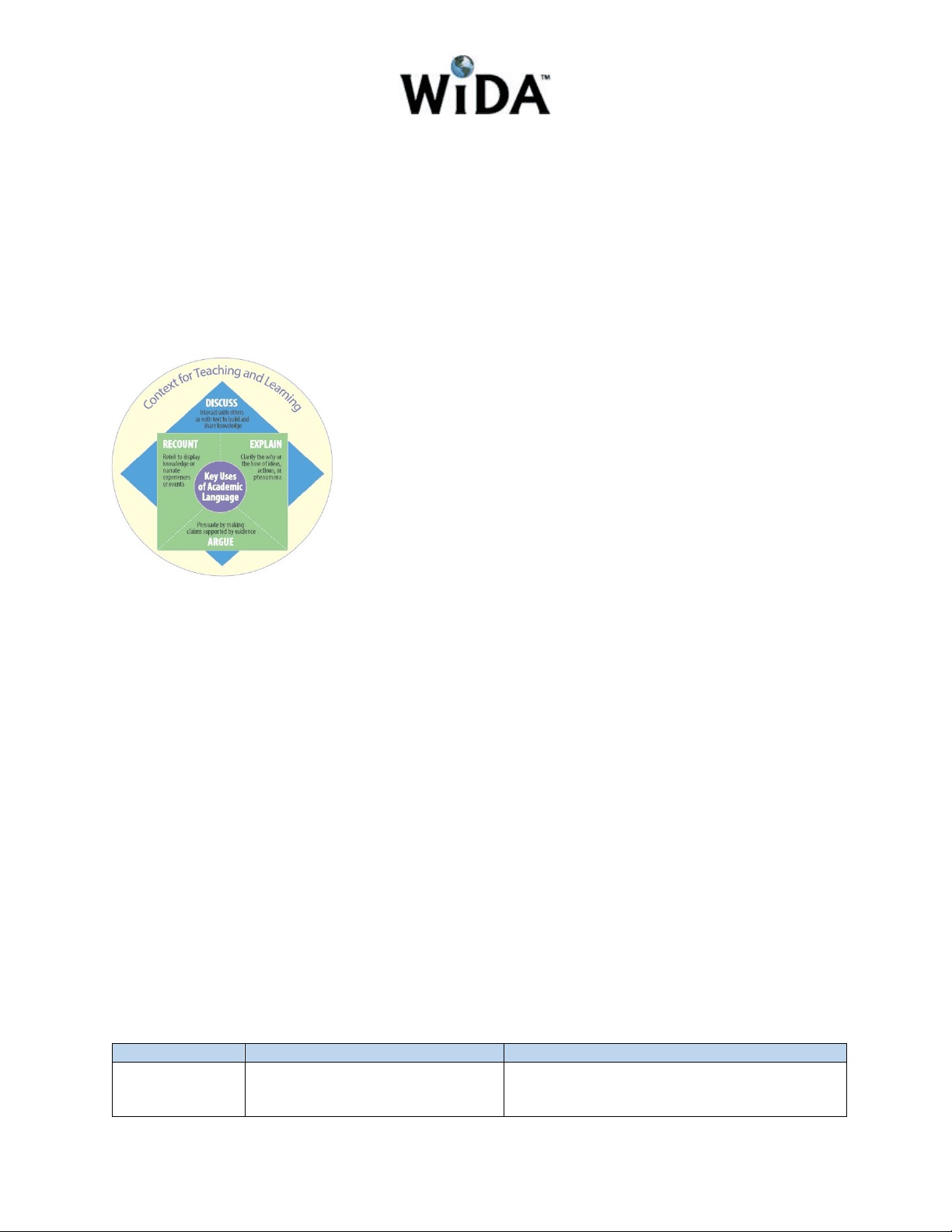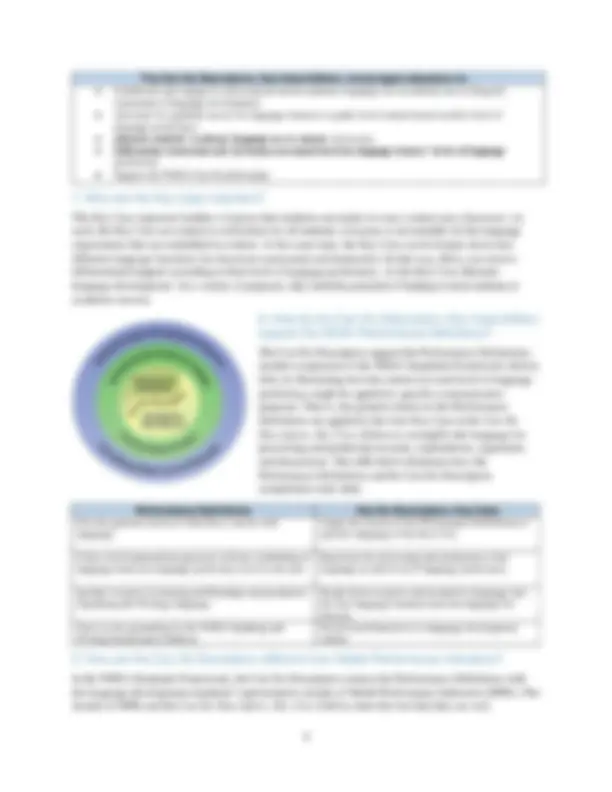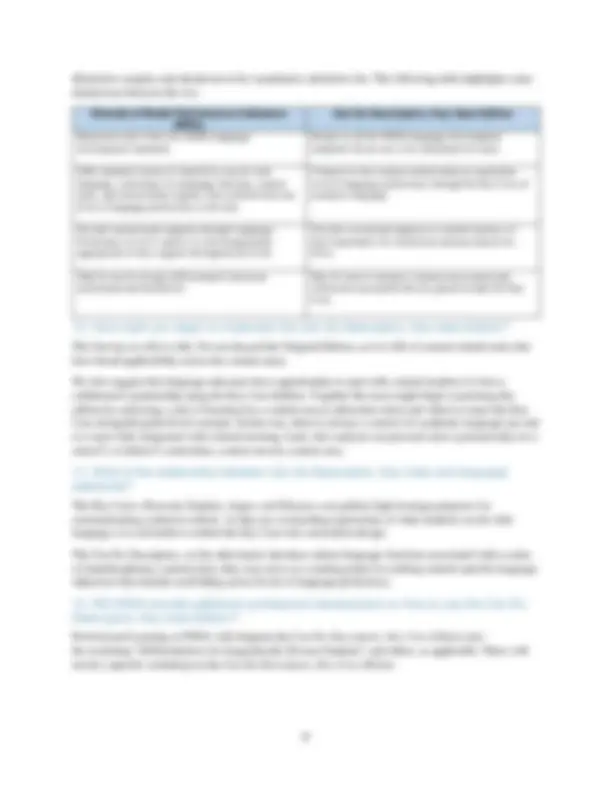




Study with the several resources on Docsity

Earn points by helping other students or get them with a premium plan


Prepare for your exams
Study with the several resources on Docsity

Earn points to download
Earn points by helping other students or get them with a premium plan
Community
Ask the community for help and clear up your study doubts
Discover the best universities in your country according to Docsity users
Free resources
Download our free guides on studying techniques, anxiety management strategies, and thesis advice from Docsity tutors
The can do descriptors, key uses edition is a valuable resource for educators to understand what english language learners (ells) can do with language in various situations and content areas. Developed by wida in response to increasing language demands in education, this edition provides examples of language use in listening, speaking, reading, and writing at six levels of proficiency, aligned with the key uses of recount, explain, argue, and discuss. The rationale behind the edition and its development process, as well as its potential uses and applications.
What you will learn
Typology: Slides
1 / 4

This page cannot be seen from the preview
Don't miss anything!



The Can Do Descriptors, Key Uses Edition can help educators see what English language learners (ELLs) can do with language in different situations, and in different content areas, throughout their journey toward English language proficiency. It provides examples of content language use by students in Kindergarten through Grade 12, in the domains of Listening, Speaking, Reading, and Writing, at each level of proficiency, from Level 1, Entering, through Level 6, Reaching. The example descriptors are arranged by Key Use. The Key Uses represent four overarching communicative purposes- Recount, Explain, Argue, and Discuss (shown on left). Researchers have identified these purposes as integral to academic success.
WIDA developed the Key Uses Edition of the Can Do Descriptors in response to challenging state college and career readiness standards and the subsequent greater language demands placed on curriculum, such as those from International Baccalaureate. The edition also addresses the growing recognition of academic language use in content learning. This edition represents a broad range of what language learners can do with language to meaningfully engage in and achieve challenging content standards. The Key Uses themselves emerged from an analysis of content standards, language development standards, instructional materials, and a review of the literature in various fields of linguistics and language education.
The Can Do Descriptors, Key Uses Edition has been built from linguistic theory coupled with language education practices. Three of the Key Uses—Recount, Explain, and Argue—are critical genres tied to success in school that have roots in systemic functional linguistics. The fourth Key Use, Discuss, is directly tied to challenging state college and career readiness standards and language practices that recognize the importance of academic conversations and student interaction as integral to the process of language learning.
Both editions of Can Do Descriptors exemplify the WIDA Can Do Philosophy, which accentuates the rich assets language learners bring to our classrooms. However, as illustrated in the table below, there are some differences in the features of the two editions of the Can Do Descriptors. Feature Original Edition Key Uses Edition Purpose Provides examples of what language learners can do in Listening, Speaking, Reading, and Writing at Provides examples of what language learners can do with language tied to four specific purposes of academic language use (Recount, Explain, Argue,
Feature Original Edition Key Uses Edition each of five levels of language proficiency across the five language development standards. and Discuss) in Listening, Speaking, Reading, and Writing at each of six levels of language proficiency across the five language development standards. Grade level Clusters PreK–K, 1 – 2 , 3 – 5 , 6 – 8 , 9 – 12 K, 1 , 2 – 3 , 4 – 5 , 6 – 8 , 9 – 12 Language Domains Listening, Speaking, Reading, Writing Listening, Speaking, Reading, Writing Levels of Language Proficiency 1 (Entering)– 5 (Bridging) 1 (Entering)– 6 (Reaching) Communicative Purposes Not stated Recount, Explain, Argue, Discuss
The Key Uses—Recount, Explain, Argue, and Discuss—are overarching communicative purposes that are associated with language and content learning. Here are the definitions and examples of each Key Use.
The Can Do Descriptors, Key Uses Edition represents a consortium-wide effort that involved a variety of stakeholders in the development process. Initially, nominees were selected to participate in the Can Do kick-off event in November 2014. Representatives from 14 WIDA states convened over multiple days to develop initial ideas. Multiple WIDA departments provided input, as did the Center for Applied Linguistics. The WIDA Standards team refined the descriptors prior to external review. About 5,000 K– 12 ESL, bilingual and content teachers, school leaders, administrators, and teacher educators provided comments via an online survey in spring 2015. After an analysis of the survey data, the set of Can Do Descriptors, Key Uses Edition was refined and formatted.
Here are some potential uses for the Can Do Descriptors, Key Uses Edition : Key Use Definition Examples Recount— To display knowledge or narrate experiences or events. State the steps to make something Describe experiences Order steps to get the answer Produce information reports Explain— To clarify the “why” or the “how” of ideas, actions, or phenomena. Examine relationships among content-related ideas and concepts Show relationships between cause and effect State consequences of behaviors Describe factors that contribute to events Argue— To persuade by making claims supported by evidence. State preferences or opinions Present claims supported by evidence Critique the reasoning of others Give reasons for a stance Discuss— To interact with others to build meaning and share knowledge. Contribute ideas to a conversation Extend knowledge with a mentor Elaborate ideas with peers Question and critique ideas in small groups
illustrative samples and should never be considered a definitive list. The following table highlights some distinctions between the two. Strands of Model Performance Indicators (MPIs) Can Do Descriptors, Key Uses Edition Represent each of the five WIDA language development standards Relates to all the WIDA language development standards but are not to be substituted for them Offer detailed criteria of what ELLs can do with language, consisting of a language function, content topic, and instructional support, that scaffold from one level of language proficiency to the next Connects to the content-related tasks at a particular level of language proficiency through the Key Uses of academic language Provide instructional supports through Language Proficiency Level 4, unless it is developmentally appropriate to have support throughout all levels Provides occasional supports to remind teachers of their importance for instruction and assessment for ELLs May be used to design differentiated classroom assessment and instruction May be used to interpret common assessment and classroom assessment that are geared around the Key Uses
The first tip we offer is this: Do not discard the Original Edition, as it is full of content-related tasks that have broad applicability across the content areas. We also suggest that language educators have opportunities to pair with content teachers to form a collaborative partnership using the Key Uses Edition. Together the team might begin examining this edition by analyzing a unit of learning for a content area to determine when and where to insert the Key Uses alongside grade-level concepts. In that way, there is always a context for academic language use and it is more fully integrated with content learning. Later, this analysis can proceed more systematically for a school’s or district’s curriculum, content area by content area.
The Key Uses—Recount, Explain, Argue, and Discuss—are global, high leverage purposes for communicating content in school. As they are overarching expressions of what students can do with language, it is advisable to embed the Key Uses into curriculum design. The Can Do Descriptors, on the other hand, introduce salient language functions associated with a series of interdisciplinary content tasks; they may serve as a starting point for crafting content-specific language objectives that include scaffolding across levels of language proficiency.
Professional Learning at WIDA will integrate the Can Do Descriptors, Key Uses Edition into the workshop "Differentiation for Linguistically Diverse Students" and others, as applicable. There will not be a specific workshop on the Can Do Descriptors, Key Uses Edition.